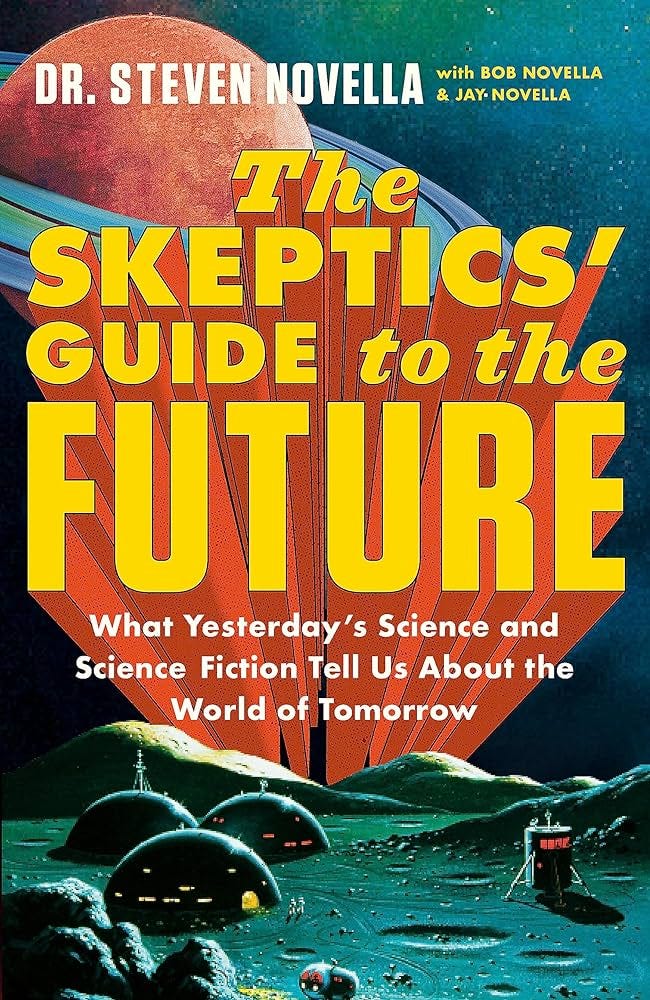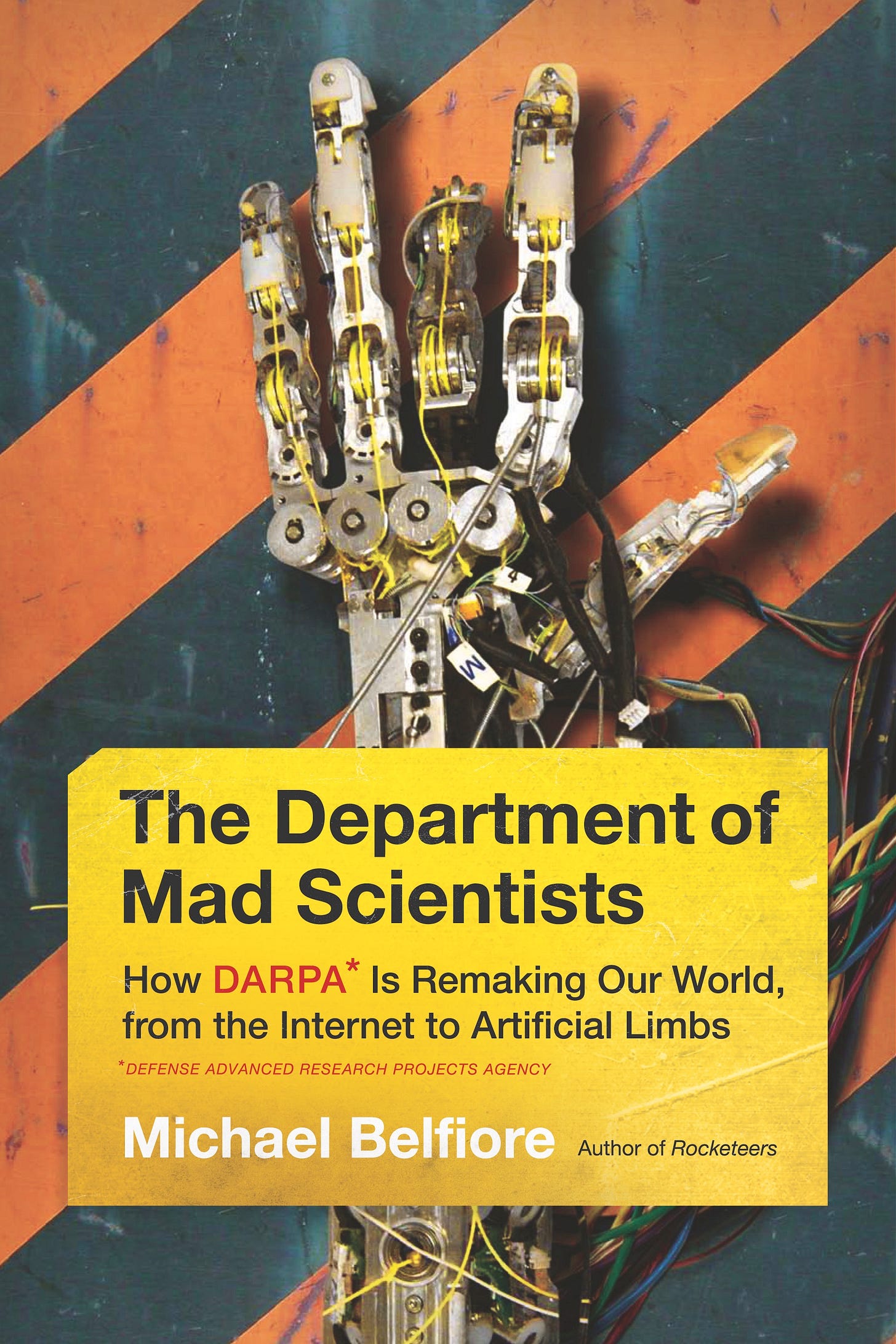Sci-Friday: Science Fiction in Foresight, Strategy and Futures Studies
Tapping into a well of data from from the future to inform our decisions for today.
TGI-Sci-Friday!
Become a defender of the creative consciousness: Today's post took considerable effort, so please hit that like button, it really helps. Only you can hack the algorithm and help spread the good word of design fiction and the power of imagination.The business of the future has been on the rise in the last few years. There are so many great frameworks and techniques to help envision future scenarios, but I’ve always found the best scenarios to come out of science fiction. Authors like Neal Stephenson and Kim Stanley Robinson have developed prescient ideas in story form, replete with characters and emotion, intention and obstacle, and rich in world building. It’s hard to find any futures report that brings the future into such vivid detail as a well-written piece of science fiction.
Mind you, not all of us are science fiction authors, yet we still have poignant ideas about the future. This is where tapping into the well of science fiction (especially when expressed through design fiction) to inform our reports and scenarios can help make them richer.
Today’s entry is all about the merging of Science Fiction and Strategic Foresight with some tool and book recommendations to supplement what you’re already using.
Science Fiction as Data from the Future
This slide, from presentations I delivered around 2017 and 2018, highlights a significant blind spot inherent in our understanding, emphasizing the necessity to delve into data for clearer insights. However, when we think about the future, it may seem like data isn’t readily available. Or is it?
If all of our data is from the past, where do we find data from the future?
I think science fiction is that data set. With hundreds of thousands of narratives at our disposal, many crafted with a specific goal and anchored in possibility12, the genre unveils numerous potential pathways. Often, recurring themes or motifs emerge, indicating a communal resonance with certain concepts. As the saying goes, "Never ignore a landslide"3 when a notion garners widespread attention.
Delving into these narratives, absorbing the diverse ideas and historical evolution of science fiction4, and then integrating these insights into solid strategic frameworks for exploring the future can significantly enhance our output. The more perspectives you encounter, the richer the network of connections you can establish in your work.
Below are some book recommendations that spotlight the intersection of science fiction and practical foresight, offering valuable insights for businesses, organizations, and communities looking to navigate the unknown ahead.
Science Fiction Prototyping:
Designing the Future with Science Fiction
“Science Fiction Prototyping” argues that science fiction, with its imaginative settings and plots, can serve as a powerful tool for researchers, scientists, and corporations to conceptualize and test new ideas in a fictional but plausible world. By doing so, these speculative stories can provide insights into the ethical, societal, and practical implications of emerging technologies long before they become a reality.
In essence, "Science Fiction Prototyping" advocates for a future where science fiction serves not just as entertainment but as a critical tool5 in designing and anticipating the world of tomorrow.
Lab Coats in Hollywood:
Science, Scientists, and Cinema
“Lab Coats in Hollywood” delves into the intriguing intersection of science and cinema, exploring the relationship between Hollywood filmmakers and the scientific community. David A. Kirby, a historian of science, examines the role that scientists have played in the production of films, from the golden age of cinema to contemporary blockbusters.
The book underscores the mutual benefits of this collaboration: while filmmakers gain credibility and accuracy in their portrayal of scientific concepts and characters, scientists receive a platform to communicate complex ideas to a broad audience and potentially shape public perception of science.
The Dreams Our Stuff is Made Of:
How Science Fiction Conquered The World
"The Dreams Our Stuff Is Made Of" offers a provocative and insightful exploration of the cultural impact of science fiction on the American psyche. With a blend of wit, criticism, and historical analysis, Disch delves into the ways science fiction has both reflected and shaped societal beliefs, aspirations, and anxieties.
The book delves into the paradoxes inherent in the genre. While science fiction has been a vehicle for critiquing societal norms and projecting utopian futures, it has also been a realm where racial, gender, and colonial biases have been both challenged and perpetuated.
Disch doesn't shy away from critiquing some of the revered giants of the genre, pointing out where they've been prescient and where they've faltered. He also examines the commercialization of science fiction and its mainstream acceptance, highlighting the genre's influence on everything from politics to technology to pop culture.
The Skeptics' Guide to the Future:
What Yesterday's Science and Science Fiction Tell Us About the World of Tomorrow
Note: I have not read this book yet, but it's on my list. I've copy/pasted the book description below from the author's website.Our predictions of the future are a wild fantasy, inextricably linked to our present hopes and fears, biases and ignorance. Whether they be the outlandish leaps predicted in the 1920s, like multi-purpose utility belts with climate control capabilities and planes the size of luxury cruise ships, or the forecasts of the ‘60s, which didn’t anticipate the sexual revolution or women’s liberation, the path to the present is littered with failed predictions and incorrect estimations. The best we can do is try to absorb the lessons from futurism’s checkered past, perhaps learning to do a little better.
In THE SKEPTICS’ GUIDE TO THE FUTURE, Steven Novella and his co-authors build upon the work of futurists of the past by examining what they got right, what they got wrong, and how they came to those conclusions. By exploring the pitfalls of each era, they give their own speculations about the distant future, transformed by unbelievable technology ranging from genetic manipulation to artificial intelligence and quantum computing. Applying their trademark skepticism, they carefully extrapolate upon each scientific development, leaving no stone unturned as they lay out a vision for the future.
The Department of Mad Scientists:
How DARPA Is Remaking Our World, from the Internet to Artificial Limbs
"The Department of Mad Scientists" is a significant exposition on the Defense Advanced Research Projects Agency (DARPA). Founded by President Eisenhower in response to the Soviet Union's Sputnik program6, DARPA melds military officers with unconventional scientists to pursue groundbreaking ideas across diverse fields such as energy, robotics, aeronautics, and medical technology.
The book highlights the agency's futuristic endeavors which have had remarkable military and civilian applications, including the inception of the Internet, GPS, and autonomous vehicles. Belfiore explores the agency's maverick nature and the crucial, albeit underreported, role it plays in advancing science and technology.
A New History Of The Future in 100 Objects
A Fiction
by Adrian Hon
While A New History of the Future in 100 Objects is a work of fiction and a parody of A History of the World in 100 Objects, I think this is a wonderful book that rapid-fires futuristic ideas one page at a time.
In the year 2082, a curator looks back at the twenty-first century, offering a history of the era through a series of objects and artifacts. He reminisces about the power of connectivity, which was reinforced by such technologies as silent messaging—wearable computers that relay subvocal communication; recalls the Fourth Great Awakening, when a regimen of pills could make someone virtuous; and notes disapprovingly the use of locked interrogation, which delivers “enhanced interrogation” simulations via virtual reality. The unnamed curator quotes from a self-help guide to making friends with “posthumans,” describes the establishment of artificial worlds on asteroids, and recounts pro-democracy movements in epistocratic states. In A New History of the Future in 100 Objects, Adrian Hon constructs a possible future by imagining the things it might leave in its wake.
This book is incredible fodder for design fiction, don’t be surprised if you see me excavate some artifacts from these stories during my travels in the janky time machine.
I hope you appreciate this batch of book recommendations. Please let me know in the comments below if you’ve read any of these of if you feel I missed anything. I’m eager to add more titles like this to my bookshelf.
Have a great weekend.
Footies!
Hard sci-fi for the win here. There are numerous inventions that have been predicted in science fiction because the author considered physics and imagined harder about what could and couldn’t be done. From the submarine, to the space rocket, to cell phones and how we use gesture-based navigation to interact with them, all of these were envisioned in science fiction before they were invented in real life.
I posted a video supercut of science fiction ideas that were envisioned before their existence on this design fiction daily post: The Art of Science Fiction and Science Fact
“Never ignore a landslide” is an expression I use as a creative director working with teams undergoing peer review on their ideas. If enough people, love, hate or point something out, no matter how you feel, you mustn’t ignore.
Check out my post: Small Stories Filled with Big Ideas, for recommendations on two excellent sci-fi data sets (aka anthologies) you can use to upgrade your perspective in short (stories) order.
I bought a used 1st edition signed copy of this book almost 10 years ago when I was spinning up an R&D lab and an agency. This book gave me the confidence that what I was doing was worthwhile and had strategic merit.
In presentations I sometimes talk about how Sputnik sparked the mid-century sci-fi movement and fascination. This new technological achievement opened the door to a thousand ‘what ifs’ and fascination around space travel, leading to a sci-fi explosion, and eventually Star Trek. The same can be said with what’s going on today. There are so many new technologies sparking myriad ‘what ifs’ in modern sci-fi, from movies like Her and Ex-Machina, to series like Black Mirror and books like Ministry for the Future.











I haven't read any of these yet, but this is my jam.
Also super duper meta: I'm writing about you writing about writing about writing sci-fi.
Whoa.
Wow...Thank you. This is the kind of content that will change my status from free to support. Gracias Dre.